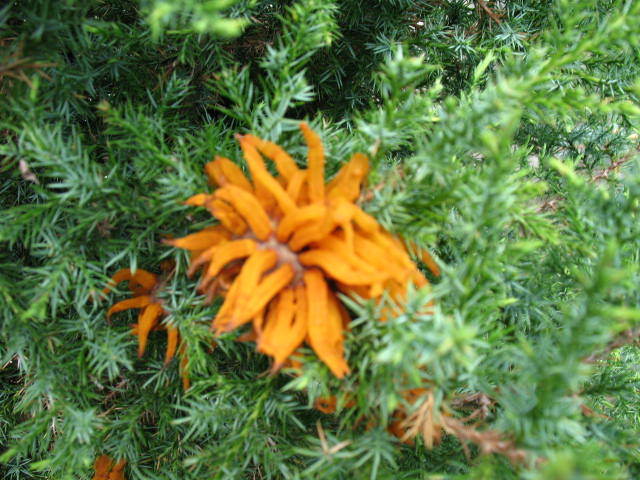Question
 plant
plant
I have a shrub that started growing on its own in my landscaping area. I didn't plant it. It appears to be in the conifer family (maybe). It's 2.5 feet wide and 7.5 feet high and probably several years old. It's a fast grower.
This spring it had pods on it that were round, orange, with rubbery like feelers protruding from it. I've attached a picture
Hope you can identify it for me. I'd like to actually plant some more.
AnswerYes you are right it is a conifer more than likely a cedar (juniper species). I can not tell from the picture which one though. The orange pod is not part of the tree but a disease called cedar apple rust. The gelatinous stage of cedar apple rust is in the spring. This is how the fungi spreads by producing spores. All Rust fungi need to two hosts to complete the life cycle. In this case cedar and the other host apple type species. Most of the year the cedar stage of the fungi will be small golf ball size "balls" on the limbs. These really do not harm the cedar tree and the dried ones will drop off after a couple of years. And are not real noticeable except when they "bloom" in the spring. Does not really harm the cedar trees.
On apples trees it does cause damage to the foliage and the fruit. The rest of the disease cycle is on apples. Here it shows up as blotches on the leaves and on the skin of the apple fruit. Symptoms of cedar-apple rust on flowering crab and apple are easily identified. In late spring or early summer, bright, yellow-orange spots approximately 1/8 to 1/4 inch in diameter form on the upper surface of leaves. These spots gradually enlarge and turn orange. Small black fruiting structures (pycnia) of the fungus form in the center of the lesion. An orange gelatinous matrix often may be seen oozing from the fruiting structures during wet weather. Eventually, an orange, cup-like fungal structure (aecium) forms on the bottom surface of the leaf directly beneath the lesion on the upper surface. This structure has small, tube-like projections in which dusty-orange spores of the fungus are produced.
Leaves with numerous spots drop during the summer. Premature defoliation weakens the tree and reduces fruit set and yield the following year. Trees with severe defoliation also are susceptible to other diseases. Cedar-apple and cedar-quince rust may cause fruit lesions. Diseased fruits develop deep pits or become distorted and usually drop before harvest.
Fungicides are used on apple trees but no control is needed on the cedar trees. Here is a fact sheet that gives more information if you want it. http://plantclinic.cornell.edu/FactSheets/cedar-applerust/cedar-applerust.htm
On cedar the balls can be pruned off and this will stop the orange blooming. Most of the year the balls are not very noticeable and really do not harm the cedar.






